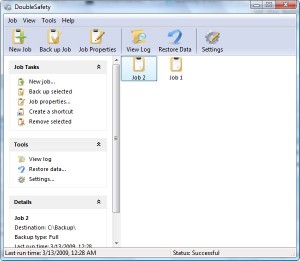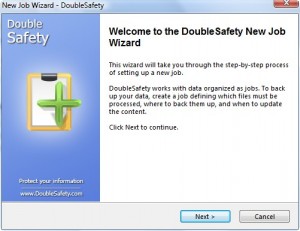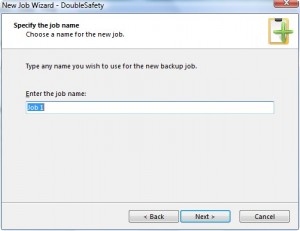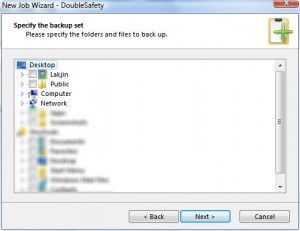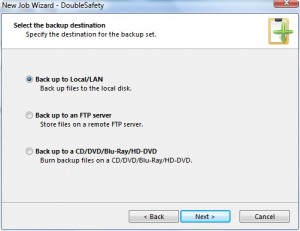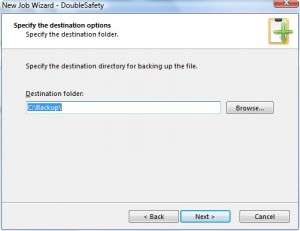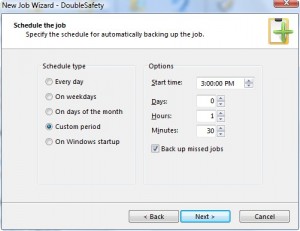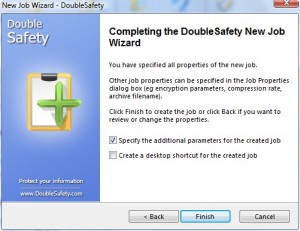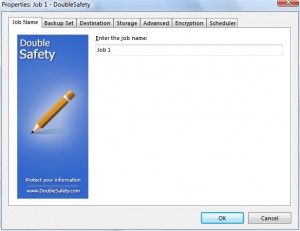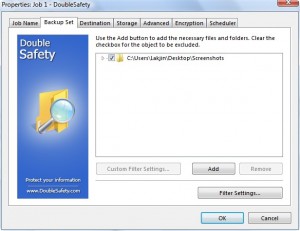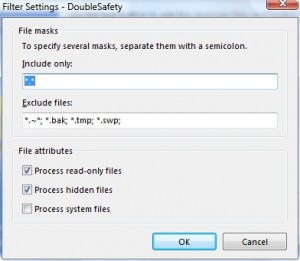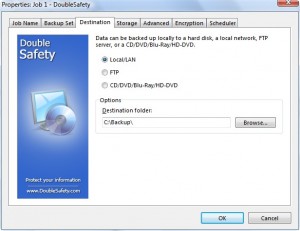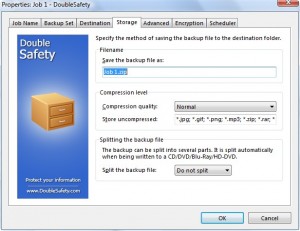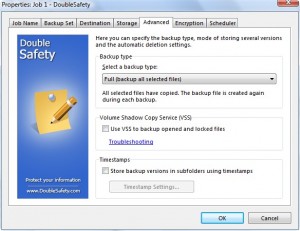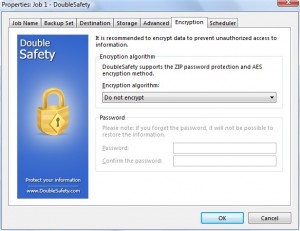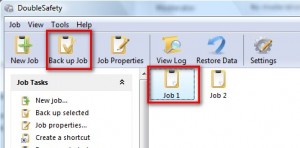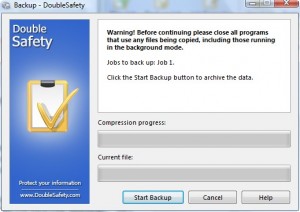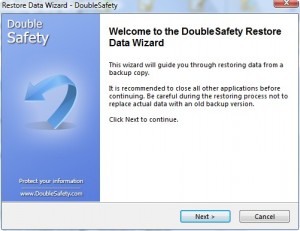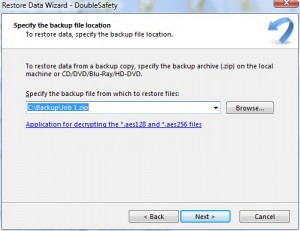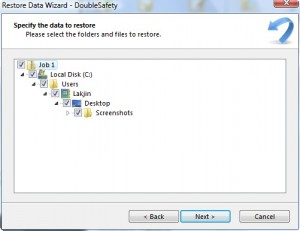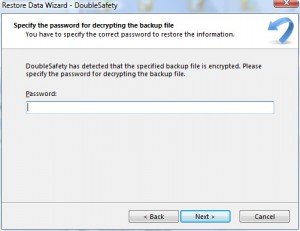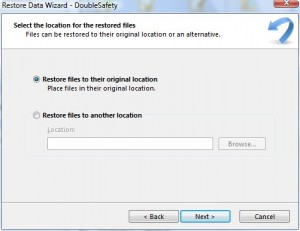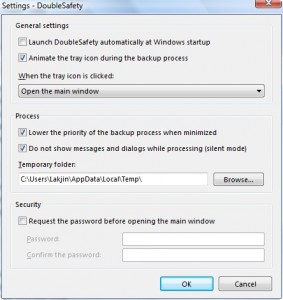{rw_text}Giveaway of the day for March 13, 2009 is:
Version reviewed:
4.3.0.124
Software description as per GOTD:
DoubleSafety is a program for automatic data backup. With an effortless user interface, you can store backups on your hard drive or use a local area network, send them to an FTP server or write to a CD or a DVD. You can also automatically encrypt data using the 256-bit AES algorithm.
Benefits of using DoubleSafety:
- Thought-out interface;
- Writing backups to CD/DVD and Blu-Ray/HD-DVD;
- Uploading backups to an FTP server;
- Encrypting according to the AES standard;
- Incremental and differential backup;
- A powerful and flexibly customizable scheduler.
————————-{/rw_text} –>
{rw_good}
- Nice clean interface.
- Decent backup speed.
- You can specify what type of backup you want.
- You can exclude X file type from backup.
- You can include X file type only in the backup.
- You can exclude X file type from compression.
- Good compression rate.
- You can encrypt your backups.
- Scheduler for automatic backup.
- You can backup to disc, local/lan folder or FTP.
- You can restore your backups from within the program.
- Self extracting backup files.
- You can backup multiple locations in one backup or “Job”.
- You can have the program save old versions of your backup file.
- You can password protect the actual program.
{/rw_good} –>
{rw_bad}
- No registry backup.
- A sync feature would have added a nice touch.
- Deleting a job from within the program does not delete the backup file on your computer.
- Renaming a job from within the program does not automatically rename the backup file on your computer.
- Burning backup onto a disc has no option to create an ISO if you don’t have a disk on hand.
- “Differential” and “Incremental” create new .zip backup files instead of modifying current backup file.
- The .zips created by “Differential” and “Incremental” must be restored one at a time instead of automatically being restored together via the restore feature.
- Need more visual confirmation message boxes.
- Restoring a backup file in a different location other then the original is done very badly.
- If you pause then cancel while running a job, if you have a back up file already, it will be deleted.
{/rw_bad} –>
{rw_score}
{for=”Features as Described” value=”10″}Yes I have complains against the program, but everything is there that the developer claims and everything works.
{/for}
{for=”Ease of Use” value=”7″}This gets a 7 because the restore feature could be made more user friendly.
{/for}
{for=”Performance” value=”8″}Not the most lightest on computer resources but not very heavy either. Backups are done at a good pace; encryption rate is good also.
{/for}
{for=”Usefulness” value=”10″}Who does not need ot backup their files?
{/for}
{for=”Arbitrary Equalizer” value=”8″}This category reflects an arbitrary number that does not specifically stand for anything. Rather this number is used to reflect my overall rating/verdict of the program in which I considered all the features and free alternatives.
{/for}
{/rw_score} –>
{rw_verdict}[tup]
{/rw_verdict} –>
Going back to the traditional Setup.exe and Activate.exe method, installation and registration was no problem for today’s giveaway.
One interesting fact to note: DoubleSafety is very similar to an earlier giveaway Document Backup. The interface of both program are the same (only icons have been changed), both programs have similar features, and both programs work in the same way. I don’t know if the developer just rebranded the software or both DoubleSafety and Document Backup are resales of some other software. What I do know is that DoubleSafety is better then Document Backup in the sense that it has addressed/fixed a few of the grievances I pointed out in my review of Document Backup – mainly the fact that AES encryption did not work with Document Backup (it works with DoubleSaftey).
That being said, even though DoubleSafety may be a rebrand, it is still a pretty nice program. It allows you to easily backup, and restore, your folders and files. Being able to encrypt your backups and having your backups work on a schedule are nice pluses. However it is still missing one key feature that a backup program should have: being able to backup the registry.
This is what the program looks like:
However, when you first run the program, you will actually be prompted with with the “Create a New Job” wizard before you get to the window I showed you above:
This is the wizard is the same thing you would get if you hit the “New Job” button you see at the top of the main program window. The “Jobs” in this programs are what create the backups. With the “Create a Job” wizard you will be guided step by step in the process of creating a “Job” which will in return allow you to create a backup. Everything is very self explanatory:
- First you name your job.
- Then you chose what files/folders you want to backup by ‘checking’ them.
You can backup as many files/folders in one ‘job’ as you like.
- Then you have to choose where you want to place the backup – in a folder on your location computer, in a folder on your LAN, in an FTP location, or burned onto a CD/DVD/Blue-ray/HD-DVD. Note that for the burning onto a disc, you must actually have a disc on hand – the program will not create an ISO that you can burn later.
- Depending on which option you chose, the next screen will vary. If you chose to back up to Local/LAN, you will be prompted to chose a location on your computer (you can chose a LAN folder also). By default it is C:/Backup/.
If you chose FTP, you will have to input your FTP information.
If you choose to burn it onto a CD, there will not b specific window for that. You will just be brought to the next window in the process, i.e the next bullet point under this one. :D
- After you chose and set your location, you can chose to either schedule the backup to occur automatically as your designated time, or you can chose not to schedule backups and manually backup yourself. If you chose not to schedule a backup, you will be brought to the end window which is described in the next bullet point. If you chose to schedule a backup, you will be prompted to setup that schedule. You can schedule a backup to occur everyday, just on weekdays, on the first day, or at Windows boot. You also have the option to setting a custom time frame, which is the option I have selected in the below screenshot:
- At the last screen, you can check an option that will allow you to create an icon on the desktop that you can click which will initiate the backup process.
Also, checked by default, is the option that will make the”Preferences” of the job appear after you hit “Finish”. These ‘preferences’ are the same that would appear if you select a specific job press the “Job Properties” button from the main program window. These “Job Properties” include everything you just setup via the create a job wizard + give you a few more options. For example, you can change your name from job properties, add/remove backup sources, etc. However, from job properties, you can also do things like choose to change the name of the actual .zip backup file from the default name it acquires from the job name to anything you want. You can also specify filters, the compression type, and what file types to exclude from compression. Other features, such as back up method, and encryption are also available.
Job Name
The only thing you can do from this tab is change the job name. There is one thing to note. Changing the job name will not change the name of the actual backup file on your desktop if you have already backed up once. For example, I have Job 1. I backup Job 1. This places Job 1.zip on my computer. Then I come here and change the job name to “Ashraf is cool”. Job 1.zip, the actual backed up file on my computer, is still named Job 1.zip until I change it also.
Backup Set
From here you can add/remove folder/files as the backup source. Also, you can set filters, i.e. rules by which the backup will abide by. For the whole general backup, if you click on “Filter Settings” you will be able to specify that only X file type be backed up or to exclude X file type from the back up:
If you click on a specific location, such as the C:/Users/Lakjin/Desktop/Screenshots seen in the above screen shot, and click on “Custom Filter Settings” you can do the same thing as you can if you clicked on “Filter Settings” but this filter applies to just that specific location you have selected.
Destination
This tab allows you edit your settings concerning where you place your backup (on your computer, FTP, disc, etc.)
Storage
Now from here is how you can change the name of the actual .zip backup file on your computer. Note that the name of the .zip backup file is set by default to be the same as the original job name. Meaning that if you change the job name after creating the job, the .zip backup file name will not be changed automatically. Once you create Job 1, the backup file name will always be Job 1.zip until you rename it, even if you change the name for Job 1 to “Ashraf is cool”.
Then you have the ability to chose the compression quality. You can chose from “No compression”, “Super Fast”, “Fast”, “Normal”, “Extra”. That list is in order of least compression to most compression; it is also in order of fastest backup to slowest backup. For reference, on “Extra” compression, the backup of my Avira folder is ~48 MB where as the original folder is ~63MB. Not the best compression, but pretty good none the less.
At the same time, right under compression quality, you can specify certain file types for DoubleSafety not to compress in your backup. As you can see, .jpg, .gif, .png, .mp3, .zip, .rar, .arc, .cab are set by default not to be compressed. You can add more files to this; just be sure to follow the same format as you see there already.
Lastly, you can make it so the backup file will be split up. As the text says, if you are burning to a CD or DVD, the backup file will automatically be split up. But if you are not burning and you still want to split up the back up files, you can specify it from here. You can set it to split up to CD size, DVD size, or a custom size.
Advanced
From this tab, you can chose what type of backup to do. By default, it is set to “Full” backup. This type of backup will copy all the files, regardless of if they have been changed or not, and back them up. However, from the drop down menu, you can choose a “Full” backup that also copies all the files but updates files that have been modified or changed since the last backup (any backup) instead of overwriting them.
You can also chose “Incremental” backup. This will only backup new/modified files that have been changed since your last backup – any backup. The only problem with this method is that it creates a new .zip every time you run it. This is a big con because 1) it is really annoying to have tons of .zip files for the same backup running around 2) easy to lose one of the .zip files effectively screwing you and 3) you must restore each .zip at a time, meaning that if you use the ‘restore’ feature, not all the .zips will be used to restore your backup, only the one you specify.
Lastly, there is “Differential” backup. Although the label says “backup new/modified files since the last full backup”, this backups up new/modified files since the last full and incremental backup (you will get a popup window informing you of this fact). The backup, in terms of creating and managing .zips, works the same way as Incremental.
Other then that, you can also make it so the program backs up files that are ‘locked’ or ‘open’. You know sometimes when you try to delete a file, you may get a message ‘cannot complete because file is in use’? In normal circumstances, this program would have problem backing up that file that is in use, but if you check this option, it will pull the file from the shadow copy to backup.
Finally, you can make it every time you make a full backup, instead of replacing the older archive, the program will create a new .zip back up file and place the older one in folders marked with its backup date. This way you can keep backups of the .zip back up files.
Encryption
From here you can encrypt your backup files. You can chose “Zip File Protection”, “AES 128” or “AES 256”. Zip protection is not actual encryption – it is just adding a password to your .zip file so anyone trying to extract it will be asked for a password. AES 128 and AES 256 is actually encrypting your backups. With Document Backup AES 128/256 encryption did not work. However it works with DoubleSafety.
Scheduler
Here to can change when your backup is schedule to automatically run, or add a schedule if you did not add one earlier.
After you are done with all your settings, just hit “OK”. This will finish creating your ‘job’.
So after you are done creating a job, it will appear as an icon in the main program window. What now? Well you can manually back up your files for one. If you want to manually backup files designated in a job, just click on a job and hit “Back up Job”:
This will not automatically start your backup. This will bring up the following window, from which you have to hit “Start Backup” to start the actual backing up of your files:
After the backing up is finished, this window will close automatically and you will be brought back to the main window. There is no visual confirmation, like a pop up message box, telling you that it finished. Be warned that if you hit “Pause” then “Cancel” after starting the backup, you will run into a problem if you already have a previous back up file created – the back up file (the .zip) will be deleted!
Other then manually doing a backup, you can also add a shortcut to your desktop of that specific job just like you could during the creation of the job. Just hit the “Create a shortcut” form the left hand menu at the main program window while you have your desired job selected. This will place a shortcut on your desktop linking to the job. There is no visual confirmation that the shortcut was successfully placed but once you click it, it should be done.
When you are ready to restore your backup, you can do it two ways. You can either go to the folder where you have the .zip backup file and extract it to a location that you desire. Or you can select the job from the main program window and hit “Restore Data”. The difference is that if you manually extract the files, all the folders within the zip will be extracted, meaning C, program files, users, desktop, etc. So to let the program restore your backups, once you hit the “Restore Data” button from the main program window, a wizard will guide you through on how to restore data:
You may notice you can only select one .zip file from here. So, if you use Incremental or Differential backup, you will have to do this step by step and chose each .zip one at a time! Hit “Next” when you are ready. You will see:
If you had selected multiple locations/files to backup within one job, you can choose to only restore specific folders or files. After you hit “Next”, if you password protected or encrypted your backup files, you will be prompted with you enter your password. If you did not password protect, this screen will be skipped:
After you hit “Next”, or if you did not password protect/encrypt, you will see:
From here you can chose to restore the backup files right back to where they were originally when you backed them up, or chose to put them in a different location. If you chose them to put in a different location, you should be warned that not just your backup files will be extracted. All the folders within the zip will be extracted, such as the C, program files, users, desktop, etc. folders – it would be just like if you manually restored your backup. Hit “Next” when you are ready. The restoring will start. After the restoring is done, a window will tell you so, and you will have to hit “Finish”.
The last thing I would like to show you about this program is the settings:
The only thing I want to point out is the security at the bottom – you can password protect this program.
Overall, I give DoubleSatefy a thumbs up. It is a good program that is easy to use and worth what you are paying for it today :P. Some of you may recall that I gave Document Backup a thumbs down back when it was given. However I feel DoubleSafety has addressed enough of the issues I had against Document Backup to earn it a thumbs up. That being said, there still are problems with DoubleSafety that should be addressed:
- Horrible method of incremental and differential backup.
- Deleting a job does not delete the actual .zip file.
- Restoring is done badly if you do not restore back to its original location.
- Lack of ‘confirmation’ messages such as when you are done creating a backup.
- Someone can accidentally delete their back up if they hit “Pause” then “Cancel” a job that they started the backup.
{rw_freea}
Cobian Backup is a popular backup utility that is time tested. Generally, the features and purpose of both these backup programs is the same. The main difference is that Cobian is a lot slower but has a slightly better compression rate while DoubleSafety is faster. Also worth noting that Cobian Backup does not have a ‘restore’ feature built in.
From Developer’s Website:
- Easily backup files or folders anywhere on your computer, network, DVD-RW, CD-RW or FTP server
- Files can be written to a multi-session DVD if it already contains a file with the same name
- Email, FTP, zip and configuration passwords are stored in the registry with encryption
- Protect yourself against ever losing those critical files that took hours to create
- Quickly recover your data in the event of data loss
- Schedule backups to run automatically at a time that suits you
- Synchronized backup feature – save a file and it gets copied instantly
- Send E-mail notifications to team members about the status of a backup job
- Save Disk space by compressing your backups as ZIP files
- Configure in minutes with our intuitive interface
Titan Backup 1.5 is a commercial software now being offered by the developer in order to entice users to purchase Titan 2.5. Titan Backup 1.5 is an excellent tool that is the best out of all three in my opinion. The backup speed is about the same as DoubleSafety but the compression is slightly better. The two key features that make Titan Backup better is the fact that it can backup registry files and it includes a feature where you can sync folders. One bad thing about Titan Backup 1.5 is that the password protect is weak when compared to others (only Zip level password protect – no encryption), but I feel it is more then sufficient for backups a home user will create.
Update 8/4/09: GFI Backup has now replaced Titan Backup. GFI Backup is fully functional and freeware. It can do everything Titan Backup 1.5 did + more.
{/rw_freea} –>
{rw_verdict2}I gave Document Backup a thumbs down because it had more problems then I liked. However DoubleSafety fixes some of those problems, mainly making AES encryption of backsups work. These fixes have convinced me to overlook the other problems I see in DoubleSafety and give it a thumbs up. However, I feel that there are better free alternatives to DoubleSafety. That being said, my recommendation for today is GFI Backup. GFI Backup is just the superior backup software with its support for many third party programs with built in “plugins”, ability to backup registry and sync tool. GFI Backup can do everything DoubleSafety can and more. Thumbs up for Document Backup, but two thumbs up for GFI Backup.
{/rw_verdict2} –>

 Email article
Email article
